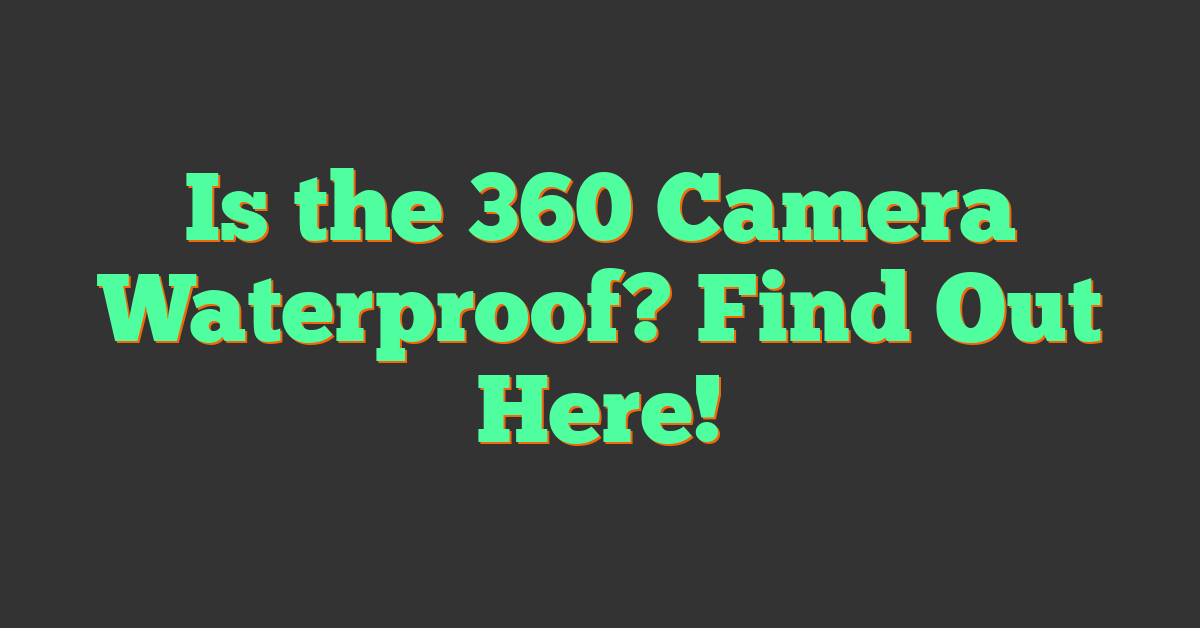Key Takeaways
- Understand your needs: Choose a 360 camera based on your purpose—whether it’s for casual use, professional content creation, or immersive VR experiences.
- Focus on resolution and stabilization: Look for models offering 8K or higher resolution and advanced stabilization for sharp, smooth footage, especially for dynamic shots.
- Prioritize durability and portability: Opt for lightweight, rugged models with waterproofing and shock resistance for outdoor or travel use.
- Evaluate compatibility and connectivity: Ensure the camera integrates seamlessly with your devices, supports fast file transfers, and offers strong app ecosystems for editing.
- Balance budget and features: Entry-level options start at $200, while professional-grade models may exceed $2,000. Choose a camera that fits your creative goals without overspending on unnecessary features.
- Explore top brands and models: Leading manufacturers like Insta360, GoPro, Ricoh, and Samsung offer diverse options tailored to different needs and budgets.
Choosing the best 360 camera in 2025 can feel overwhelming with so many options packed with cutting-edge features. From capturing immersive travel experiences to creating professional-grade virtual tours, these cameras have transformed how we tell stories and share moments. But how do you know which one fits your needs?
I’ve explored the latest trends and advancements to help you navigate this evolving market. Whether you’re a content creator, an adventurer, or just someone curious about 360 technology, understanding what to prioritize—like resolution, stabilization, and ease of use—can make all the difference. Let’s break it down so you can pick the perfect camera with confidence.
Understanding 360 Cameras
360 cameras have revolutionized photography and videography, offering immersive ways to capture the world. As a former 360 camera manufacturer employee and avid user, I find their ability to record everything around you in stunning detail both fascinating and practical.
What Makes 360 Cameras Unique?
360 cameras stand out for their ability to capture a full 360-degree view in a single shot. Unlike traditional cameras, they combine data from multiple lenses—usually two 180-degree fish-eye lenses—to create seamless panoramic images or videos. This avoids the limitations of standard cameras, which only frame what’s directly in front of them.
Virtual reality applications are one of their most exciting uses. They’re perfect for creating VR content, enabling users to relive moments with a sense of immersion. Spherical footage taken with a 360 camera also lets photographers and videographers reframe shots during post-production, offering endless creative possibilities.
Content sharing is another highlight. Many 360 cameras integrate directly with platforms like YouTube or Facebook, ensuring that immersive media can be easily uploaded and viewed in its intended format.
Key Advancements in 360 Camera Technology in 2025
The 360 camera market in 2025 boasts several major technological improvements. Higher resolutions are now standard, with devices offering 8K or even 12K recording. This sharpness matters for both detailed close-ups and wide panoramic scenes.
Improved stabilization allows smooth footage even during dynamic movement or when filming handheld. Gyroscope-driven algorithms and advanced AI ensure professional-grade stabilization, which benefits both action videographers and casual users.
Real-time editing capabilities have expanded. Many 360 cameras now include advanced in-camera software, letting users trim, edit, and add effects without external software. Time-of-flight sensors have also enhanced depth mapping, aiding in more accurate post-production edits.
« Action 360 Cameras: Waterproof Models That Capture Stunning Adventures Anywhere
Action 360 Cameras: Best Accessories to Elevate Your Filming Game »
Battery efficiency has increased significantly, allowing longer recording sessions. Coupled with better heat dissipation, these upgrades make modern 360 cameras more reliable for extended use. Additionally, enhanced waterproofing and durability features enable shooting in extreme conditions, further expanding creative possibilities.
Factors to Consider When Choosing a 360 Camera
Selecting the right 360 camera in 2025 requires evaluating features that align with your creative goals. As someone passionate about 360 photography and videography, I focus on the technical and functional aspects that enhance imagery and usability.
Image and Video Quality
High resolution matters when producing sharp, detailed images and videos. Look for cameras offering at least 5.7K video recording or up to 12K for professional projects. Cameras with advanced HDR for dynamic range and sensors that perform well in low light, like 1-inch sensors, deliver better results in various conditions. For videos, target higher frame rates such as 60fps or 120fps for smoother playback and slow-motion effects.
Field of View and Stitching Capabilities
A true 360 experience depends on seamless stitching where lens overlaps create a unified image. Choose cameras with dual 200° lenses or advanced stitching algorithms. Some models, like Insta360’s or GoPro Max, use AI-driven software for superior accuracy. For VR photographers, smaller stitching errors directly contribute to higher-quality immersive content.
Compatibility and Connectivity Options
Opt for cameras with robust wireless features like Wi-Fi 6 or Bluetooth 5.2 for fast transfers and consistency with smartphones or editing devices. USB-C and SD card support ensure expandable storage and high-speed access. I also check software ecosystems, like dedicated apps for post-processing, ensuring compatibility with platforms such as Adobe Premiere or Final Cut Pro.
Battery Life and Storage Capacity
Extended shoots demand battery efficiency. Cameras offering swappable batteries or those lasting beyond 90 minutes per charge are vital for longer projects. Some devices even enable USB charging while recording. Ensure storage matches your workflow. For instance, professional 12K footage may need 1TB or higher storage solutions to eliminate frequent interruptions.
Size, Weight, and Portability
Compact, durable designs simplify capturing dynamic shots during travel, outdoor adventures, or tight indoor spaces. I value lightweight cameras under 250 grams for their ease of handling, especially during handheld use or with gimbal setups. Additionally, features like waterproofing and shock resistance expand usability in harsh conditions while maintaining portability.
Top Features to Look for in 2025 Models
The latest 360 cameras in 2025 have advanced features that cater to both professionals and beginners. Here’s a breakdown of the most critical features shaping the market this year.
AI and Smart Features
AI advancements simplify workflows and enhance content production. Many 2025 models integrate AI-driven scene detection, which adjusts settings like exposure and color balance automatically based on the environment. Object tracking capabilities allow the camera to follow specific subjects in 360-degree space, ensuring smooth focus during dynamic shots. Examples include real-time adjustments for fast-moving sports or architectural tours. These features save time and deliver professional results without excessive manual editing.
Waterproof and Rugged Build
Durability is essential for outdoor and travel-oriented photographers. Current 360 cameras offer rugged exteriors designed to handle extreme conditions. Most mid-to-high-end models are rated IP67 or higher, providing protection against dust, water immersion, and harsh temperatures. For creators capturing underwater footage or action in challenging terrains, brands now include reinforced seals, anti-fog lenses, and shockproof casings. Cameras like these perform reliably during activities like scuba diving, mountain trekking, or desert expeditions.
Live Streaming Capabilities
Streaming 360 content has become increasingly popular for virtual events and interactive experiences. New models now support direct live streaming in high resolutions, such as 8K or more, with minimal latency. Built-in Wi-Fi 6 and 5G compatibility improve connectivity, ensuring stable streams even from remote or crowded locations. Features like instant audience interaction and VR headset integration make these cameras ideal for creators sharing real-time content, like concerts or global tours.
Editing and Software Support
Editing tools and software ecosystems determine how users post-process 360 media. Leading brands integrate their cameras with robust apps, offering AI-powered reframing, keyframe editing, and one-tap effects. Advanced software allows multi-layered editing, such as stitching corrections or VR-specific enhancements. For editors working on desktops, compatibility with platforms like Adobe Premiere and Final Cut Pro makes professional workflows seamless. Well-supported software ensures versatility and unlocks creative possibilities for photos and videos alike.
Popular Brands and Models in 2025
The 360 camera market in 2025 showcases remarkable innovation, with several brands leading in technology and design. I’ve followed these developments closely, and the top manufacturers continue to set benchmarks for professionals and enthusiasts alike.
Comparison of Leading Manufacturers
- Insta360
Insta360 consistently pushes boundaries with versatile cameras. Their models in 2025 feature industry-leading stabilization, AI-enhanced editing, and high resolutions up to 12K. Their robust app ecosystem makes editing seamless for VR creators.
- GoPro
GoPro remains a favorite among adventurers. The Max series in 2025 is more durable, with stronger waterproofing and improved low-light performance, making it ideal for action-packed 360 videos.
- Ricoh
Known for their compact Theta line, Ricoh delivers high-quality imagery with user-friendly interfaces. 2025 models emphasize real-time VR functionality and improved stitching for precise shots.
- Samsung
Samsung’s Gear 360 updates in 2025 cater to casual users, offering affordable options with reliable performance. Their cameras integrate effectively with smartphones for on-the-go sharing.
- KanDao
KanDao focuses on professional-grade solutions. Their Obsidian series in 2025 excels in cinematic-quality output with advanced HDR, catering to high-end productions.
Notable Models to Watch for in 2025
- Insta360 X4
The X4 provides 12K video resolution, real-time reframing, and gyroscope-enhanced stabilization. It stands out for its durability and water-resistance, perfect for explorers.
- GoPro Max Pro
This model features new adaptive stabilization and superior heat management, ensuring long recording sessions. Its enhanced live-streaming resolution appeals to content creators.
- Ricoh Theta Z2
The Theta Z2 introduces cutting-edge stitching software and low-light capabilities, making it great for both day and night captures.
- Samsung Gear Sphere 2025
A budget-friendly option, the Sphere offers 8K video resolution, auto-stitching, and seamless integration with Galaxy devices.
- KanDao Obsidian Prime
With dual 8K sensors and professional filming presets, the Obsidian Prime targets creators requiring precision and cinematic quality for VR projects.
These brands and models reflect how far 360 camera technology has come, delivering tools suitable for everything from hobbyist projects to professional productions. My passion lies in exploring these innovations, and I believe understanding the nuances of each option helps photographers and videographers find what aligns with their creative vision.
Budget and Price Considerations
Choosing the right 360 camera involves evaluating your budget while ensuring the features meet your creative needs. I’ve worked with numerous models over the years, and cost often dictates which features are accessible.
How Much Should You Spend on a 360 Camera?
360 cameras in 2025 range from $200 for entry-level models to over $2,000 for professional-grade options. For casual users or beginners, spending $300–$500 secures decent resolution (4K–6K), basic stabilization, and mobile app editing. Intermediate creators often look at $500–$1,000, which adds advanced HDR, stronger stabilization, and better compatibility with external accessories. Professionals seeking maximum quality and features like 12K resolution, granular manual controls, and top-tier stitching software might budget beyond $1,200. Before purchasing, balance what fits your creative goals and frequency of use.
Balancing Features and Affordability
Striking a balance between features and price is critical. Spending extra may be unnecessary if an affordable camera in your range meets key technical needs. For instance, casual vloggers could find Samsung’s Gear Sphere 2025 sufficient with solid 6K capability and real-time stitching under $450. Photographers needing advanced outputs might prioritize GoPro Max Pro’s durability and AI-enhanced tools, even at its $800+ price point. Avoid sacrificing essentials like stabilization or seamless stitching for a cheaper option, as these are pivotal in 360 content creation. Reliable mid-tier choices like Ricoh Theta Z2, priced around $1,000, often achieve this balance.
Conclusion
Choosing the best 360 camera in 2025 comes down to understanding your needs and aligning them with the features that matter most. With advancements like 12K resolution, AI-driven editing, and enhanced durability, there’s a perfect option for every creator, whether you’re a professional or a casual enthusiast.
Balancing quality, functionality, and budget is key to making an investment that elevates your content. By focusing on essential aspects like stabilization, image quality, and software support, you can confidently select a camera that transforms how you capture and share experiences.















